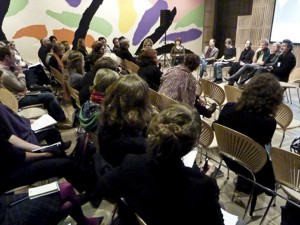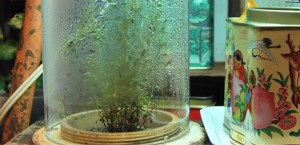The recent HotHouse symposium presented by the National Institute for Experimental Arts (NIEA) at the University of New South Wales was a gathering of experts discussing the timely topic of cultural ecology and sustainable urban environments, with representatives from design, art, architecture, curating, social and cultural theory to urban informatics, digital ethnography and sustainability.
The focus on sustainable urban environments is pertinent, given over half the world’s population now lives in cities. A United Nations Report estimates this number will grow exponentially to 9 billion by 2050.¹ Unprecedented waves of urbanisation draw attention to environmental and social costs. What is the role of culture and creative practice in the landscape of surging populations worldwide?

Hothouse Symposium Panel Discussion
HotHouse was conceived in this context, predicated on the concept of art and design as fundamental agents of change, to engage in the shaping of sustainable cities through visionary ideas and practice. Designating responsibility to these creative fields is not only possible but necessary, for at the heart of cultural ecology is the way that we envisage the world. As Professor Tony Fry said “We see the world and act in the world as a result of it being mediated by (this) image. In order to transform the situation we are in, we have to create another image of the future and of ourselves. This immediately puts cultural practice in a very significant place.”²
The challenge is two-fold: the first, to shift the mode of making from a micro level of subjective, personal worlds (artists) or product/client briefs (designers) to a macro level directed towards our collective future; the second is to communicate the significance of cultural practice and its potential for social and environmental transformation to industry, government and the community at large.
Designing for sustainability is a practice that has been steadily gaining ground, and while art is trailing in this aspect, Professor Jill Bennett, NIEA Director notes “Artists are increasingly integral to development projects”, quoting the well-known example of Highline in New York, the outcome of a collaboration between architects and artist Olafur Eliasson. The push is for aesthetics to assume a transformative function, in the words of Professor Bennett “a practical aesthetics concerned with the complexities of human desire and behaviour.”³ One such art project is Mathieu Gallois’ Reincarnated McMansion, a response to energy inefficient, greenhouse gas emitting large houses in Australia, particularly New South Wales. It will assess and rebuild on site an unsustainable McMansion dwelling into two or three best practice green homes reusing existing materials.

Make-do Garden City: Tessa Zettel & Karl Khoe, 2010. Photography: Makeshift
For sustainable art and design to extend their reach, interrelationships and networks are critical. According to Mark Pesce, the connectedness and connectivity of a city enabled through digital technology is a resource that will lead to its success – the existence of best networks alone will not automatically yield productive engagement or spread of impact: it is the effective use of networks tailored to each sustainable initiative that will engender meaningful change.
Dan Hill discussed how civic feedback loops in the form of digital traces from electronic device usage can be employed to understand the behaviour and activity patterns of the city, essential for urban planning and design. This focus on soft infrastructure is an important tool to support the key design approach of contemplating the purpose of the city: how it works, who it is for, what it produces and ways of “extend[ing] the capabilities of people, buildings and infrastructure such that [the city] can replicate itself.”
The scope of discussion at HotHouse was varied but the underpinning unanimous view is that culture and human agency are central to a sustainable future. Systemic change can only occur if we work beyond the limits of specific disciplines and ad-hoc projects in a consolidated manner with a coordinated plan.
Rachael Kiang
Rachael Kiang is the Executive Officer & Curatorial Assistant at the National Institute for Experimental Arts (NIEA) University of New South Wales
References
¹ Professor Jill Bennett, HotHouse, HotHouse Symposium, 27 July 2010.
² Mathieu Gallois, Reincarnating McMansions: Auditing, Dismantling, Rebuilding, HotHouse Symposium, 27 July 2010.
³ Dan Hill, Untitled Paper, HotHouse Symposium, 27 July 2010.
 This work is licensed under a Creative Commons Attribution-NonCommercial-ShareAlike 3.0 Australia.
This work is licensed under a Creative Commons Attribution-NonCommercial-ShareAlike 3.0 Australia.






